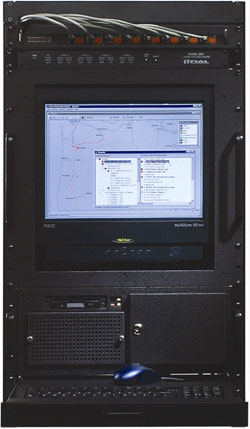NGM
  |
| Network Views | |
 |
A Global Network View shows the entire network. Infinitely sizeable vector drawings are used for the background, so infinite zoom is supported. |
 |
Sub-Networks (virtual networks) allow custom views of the network. Any sub-network may be configured to show only certain equipment and alarms. |
| Security | |
 |
Each user is assigned permissions to view specific virtual networks, run reports, perform controls, etc., independently of the operating system login. Each user has a unique NGM login name and password. |
 |
The highest alarm level (severity) which a user may acknowledge is configurable for each individual user. |
 |
All TL1 network elements are monitored for traffic. If contact with the primary gateway fails, the NGM automatically attempts to re-establish the connection using any available backup gateways. If no back up gateways are available, the NGM informs the operators of the loss of connectivity. This ensures that the NGM will always report the correct state of the TL1 network. |
 |
An optional Model 5561 unit detects NGM server computer failure and provides for external audio or visual alarm notification. |
| Alarm Notification | |
 |
One button click on a site in alarm automatically opens up the site container with the highest level alarm highlighted. No more searching through long list of points to find important alarm information. |
 |
Only one button click is required to acknowledge an alarm, a container, a site or the entire network. |
 |
The user can create derived or Boolean alarms, which are combinations of the states of multiple alarms, status and control points, and analog values. These Boolean or derived alarms have all the attributes of normal alarm points. |
| Controls | |
 |
Control commands can be executed for both MCS-11 and TL1 Network Types. |
 |
Tl1 Commands are selected from predefined list. |
 |
MCS-11 controls can be grouped into batch commands. |
| Flexible Reporting | |
 |
History files log all events: alarm assertions and negations, acknowledgements, TL1 messages, system start and stop events, user login and logout, administrative messages and executed controls. |
 |
The built-in report writer can select events by Site, Line Group, Points, Point Name, Network, Events, Alarm Level, Users, Containers, Attributes, etc. Events categories are AND’ed together, while selections within and event category are OR’ed together. Dropdown boxes provide easy selection of specific events. |
 |
The NGM allows the user to generate and run predefined reports on a regularly scheduled basis, such as daily, weekly, monthly, etc. |
| Configuration | |
 |
A TL1 message routing editor assists in routing messages to specific containers. |
 |
TL1 messages not routed to specific containers go to a default container, so no messages are ever lost. |
 |
Flexible paging provides system alarm and network connectivity failure notifications. |
| Virtual Configurations (Network Views) | |
 |
Sites can be organized into arbitrary containers and sub-containers. Container names are user assigned, such as ‘East Bound OC3 traffic’. Alarm points and messages from physical equipment are then assigned to the containers. Any conceivable type of hierarchical organization can be achieved. |
| Simple Network Management Protocol (SNMP) | |
 |
SNMP Reporting to Master of Masters (MOM). |
| Model NGM Characteristics | |
| Server operating system | |
| Microsoft Windows 2003 Server | |
| Client operating system | |
| Microsoft Windows XP | |
| Client/server Transport protocol | |
| TCP/IP | |
| Included with the NGM | |
| Rack-mount server computer 17" LCD monitor with rack mount bezel Rack mount keyboard drawer with touchpad mouse (Client computers and/or Client licenses may be purchased) |
|
| Documentation | |
 NGM Tech Data Sheet (PDF file size Bytes) NGM Tech Data Sheet (PDF file size Bytes) |
|

